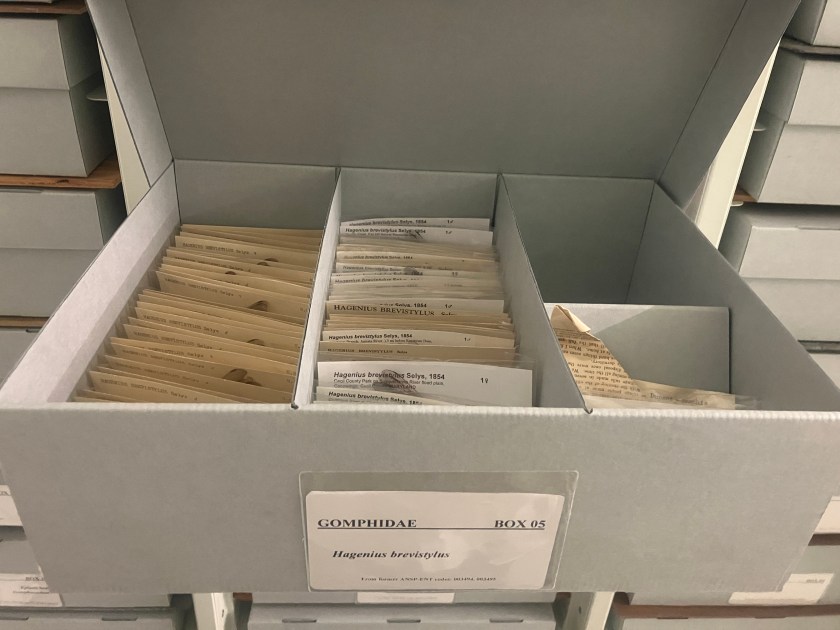Keeping 200 years’ worth of historical knowledge and 19 million specimens (and counting) in good working order is no easy feat. Not only does it require precision, care and patience, but also a whole lot of eager curiosity.
We reached out to Arthur Fink, a current Drexel University Biodiversity, Earth and Environmental Science co-op in the Academy’s Entomology Collection who recently led a big tidying-up project of enormously important insect specimens, to learn more about what goes on within the quiet — and neat — shelves of our biocollections.

Tell us more about yourself.
I’m a second-year Biology major at Drexel with a minor in Ecology. I’ve always loved animals, and I started to become interested in bugs — particularly exotic beetles — a few years ago. It wasn’t until quarantine when I started to find more time to explore nature in my own yard, rather than just through books and documentaries, that I really discovered an appreciation for the things we can find right here. It’s been a dream of mine to have a co-op here at the Academy, and I’ve been incredibly lucky to be able to have my first one in Entomology!
Although my eventual career goals involve veterinary school and potentially becoming a zoo veterinarian or wildlife rehabilitator, I still will always have a love and passion for bugs, as well as my own personal curated collection, and I plan on continuing to help out around in Entomology, like organizing and categorizing the collection, after my co-op here ends.

Why does a collection need to be organized?
The specimens I’ve been working with here date back anywhere from this year to the mid-1800s, but we still just have a single row of five cabinets to house them. We can’t just throw the old stuff away — these specimens give us valuable and irreplaceable data about a species’ range, rarity and other changes over time, and can even have DNA extracted if they’re prepared well.
Space and efficiency aside, there are many benefits to having a larger and more organized collection. For one thing, it’s much easier to identify things you find when you have access to a wide array of visual examples to study. This can be much easier than using guides or keys, even with pictures. And having a collection over a long period of time can show evolution as it’s happening.
So, what does this work entail?
Organizing or “rehousing” literally means to move all of the specimens from one method of organization or containment to another. In the case of the Odonata (dragonflies and damselflies), the specimens themselves are stored in labelled glassine envelopes, which were then stored in standard curational Odonata boxes.

However, with the way the cabinets here are built, these boxes don’t fit into the shelves right, and we had them just stacked floor to ceiling in multiple layers inside the cabinets — so it would be tedious and hazardous to try to find any specific taxa. So, the Entomology team custom ordered templates for boxes that would fit the cabinets correctly, making all of the specimens clearly labelled and easily accessible.
Throughout the entire process, I kept thinking about something Collection Manager Jason Weintraub said offhandedly at the very beginning: “The amount of stuff we house here increases, but the amount of space we have stays the same.” My main task (after folding all of the templates into boxes, kind of like a pizza delivery person) was to do the physical moving of all the specimens into these new boxes, while also incorporating a large new collection from Academy friend and Odonata specialist Hal White with specimens collected almost every summer from 1960 to 2021, as the collection was picked up early 2022.


There were two major things to keep track of as I worked: firstly, I had to make sure that as I filled boxes, I kept track of the codes written on the old Odonata boxes, because they connected to the Academy’s online database of where everything is kept in the collection.
Secondly, I had to keep track of any taxonomic changes that were made. For that, I mostly used the World Odonata List, which was a really good comprehensive list of every extant species in the Order. Whenever there were discrepancies, I researched online for information on name changes and taxon movements. Luckily, there weren’t any major hicks.
Why do we need to keep that kind of information tidy?
Taxonomy, ecology and conservation are intertwined and depend on each other. Being related taxonomically often means sharing certain anatomical traits, food, predators, niches and all kinds of other valuable information about a group. Understanding how everything relates helps us understand why they have the differences they do, and why certain taxa flourish while others go extinct.

Of course, this base knowledge is also needed in order to better protect these groups from extinction — especially in the case of insects, whose lifecycles and roles in the environment are not always fully understood or appreciated.
As our world’s climate has changed over the past two centuries, we may see shifts in the range, distribution and physique of insects; and molecular researchers sequencing DNA can also find the more subtle genetic changes in insect populations that have been fragmented and isolated by habitat loss.
Oftentimes, these specimens also act as historical artifacts telling us information about the time period itself, and the historical figures collecting and preparing the insects. Now that they’ve been rehoused, they’re much more accessible both for Academy staff and for the global researchers that use our specimens.

